Blog
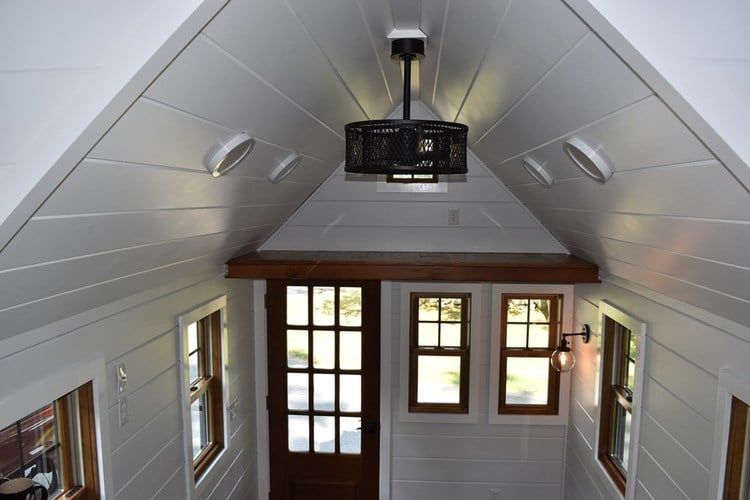
Tiny House Lighting – 7 Best Lighting Ideas
Tiny house lighting can be tricky, even to an electrician. Many of the light fixtures must be installed and hardwired on a do-it-yourself (DIY) basis due to the off grid demands of tiny houses. While some tiny houses may be built in residential areas that support ordinary alternating current (AC) electronics, most tiny homes are off the grid. This means that you will likely see direct current (DC) products or converters in tiny homes.
Whether you own a remote tiny home or a tiny home that is located in a residential area, your best bet is likely to visit a brick-and-mortar lighting store. While ordering lights online seems like the best option, sometimes it is better to get the help and opinion of a lighting professional and to visualize how the lighting fixtures will look in person. Even if you live somewhere as remote as the mountains of North Carolina, it might be worth your while to take a trip to a lighting showroom in Winston Salem, Raleigh, Charlotte, or the closest large city to you depending on just how far out there in the woods you might be!
The purpose of this article is to help you buy the most appropriate lighting fixtures to brighten up your tiny home and ensure that your living space is comfortable for you.
Continue reading if you:
- Have a tiny home that’s off-grid, and therefore are unable to tie into any modern electrical infrastructure. If you’re not off-grid and you have a tiny home in a suburb, you should be able to use modern light sources and products.
- Have a tiny space. Most tiny houses are less than 500 square feet. Small footprint means small electrical infrastructure, which means you need to be creative with the products you use. Basically, you’ll want to forego the use of pendant lights and chandeliers.
- Are looking to maximize your light. Instead of living in a cave, you’re looking for optimal ways to maximize lighting in your tiny home, or accentuate already existing colors and tones in your home.
- Have access to solar power, generators, or even your own hydroelectricity. While solar panels and generators are the most popular means to have electricity in a tiny home, I’ve heard of some tiny home owners generating their own electricity with self-constructed wind-turbines or water wheels.
- Own a tiny home that can be mobile or fixed. Either way, these suggestions should work for both.
Now that these assumptions are cleared up, here are the 7 best tiny house lighting ideas that you can use to brighten up your small home.
For indoor lighting in a tiny home:
1. Ceiling lighting
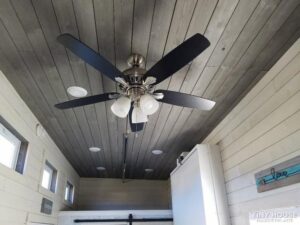
Ceiling lighting can be tricky in a tiny home due to their low ceilings and the need to conserve electricity. Fixtures like chandeliers or other types of “hanging lights” may not necessarily fit appropriately within your home. Therefore, you may want to take a look at these products:
- Wall sconces: An easy way to hard wire and a cool feature to bring accent lighting to your home. You can buy modern wall sconces or more rustic ones to match the style and feel of your home. Because wall sconces are perpendicularly wall-mounted and are not attached to the ceiling, they allow for light to radiate more horizontally across your home.
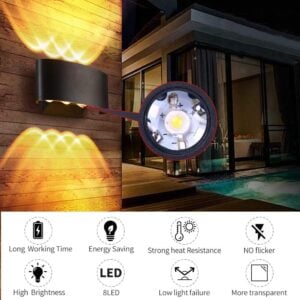
- Recessed lights, pot lights, or flush mounts: This is the most popular way to add lighting to your tiny house, especially if you have vaulted ceilings. Installing ceiling lights provide the lighting you need and give you the feeling of a more open, less tight-looking home. Usually, you’ll want to have these lights be on a dimmer because of their fairly strong brightness level.
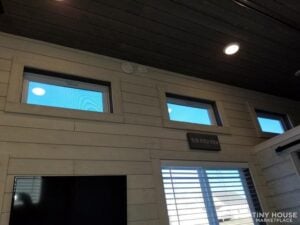
- LED strip lighting: This is a more unique way to light your home and provides more of an ambient lighting source versus task lighting (lighting that you would use to cook, work, and accomplish tasks). The amount of light provided by this strategy is somewhat more minimal than the other two suggestions, but due to it being led lighting and less invasive than recessed lights or wall sconces, it gives more of a warm feeling. You can also try a variety of colors or styles, which will give your home more expression. It also removes the need to replace light bulbs.
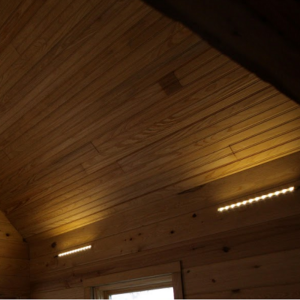 Image from Tiny Sip House
Image from Tiny Sip House
2. Maximizing daylight with windows and colors
One of the most popular ways to get more light in a tiny house is to optimize your natural light. Since tiny homes are such small spaces, there’s a variety of ways you can structure your home to take advantage of the natural sunlight:
-
- Skylights: One of the most popular ways to maximize your natural light is installing one or two skylights in your tiny house, which can make for easy daytime lighting. The skylights also make for an absolutely beautiful view of the starlight if you have a bedroom loft. Be warned though: During the colder months of the year, you will lose a lot of heat. Make sure you have adequate space heaters or insulation.
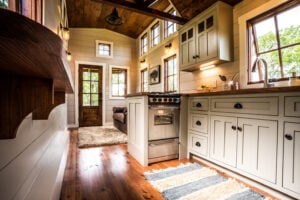
- A tiny house design for windows: Having the appropriate colors and windows can easily help you brighten up your day time in your tiny house. While types of lighting are important, ensuring you have the right mixture of color and window to wall ratio is just as important. While large horizontal windows (six by eight feet) may be excessive, I would advise for two to three ordinarily sized four by four sized windows. You may also want to consider colors that are bright like white, light blue, or yellow/beige.
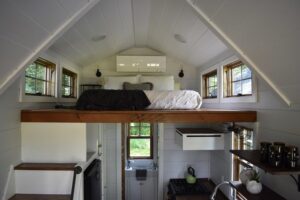
- Skylights: One of the most popular ways to maximize your natural light is installing one or two skylights in your tiny house, which can make for easy daytime lighting. The skylights also make for an absolutely beautiful view of the starlight if you have a bedroom loft. Be warned though: During the colder months of the year, you will lose a lot of heat. Make sure you have adequate space heaters or insulation.
As a word of caution, as you increase windows, skylights, and natural lighting apparatuses, there will be a trade-off with insulation and heating. This is why it’s important to have a mixture of natural lighting and artificial light. You’ll also likely need night lights, so look to augment your natural lighting strategy with some of the other ideas in this article.
3. Kitchen lighting
The best lights for home kitchens are the ones that illuminate the whole kitchen, allow you to perform tasks conveniently, and make the space spacious. Accent and task lighting that doesn’t occupy much space are ideal for this purpose.
Place It After – is just logical.
- Internal cabinet lighting: Using LED strip lights, or even halogen bar lighting, you can build lighting directly into cabinets. While you may not have the most optimal lighting experience, your cabinets should give enough illumination to function in your kitchen at any time of the day.
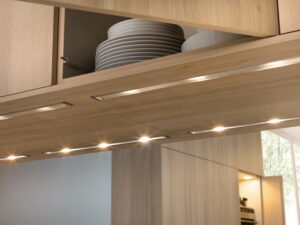
- Wall sconces or down lighting: As mentioned previously, you can never go wrong with wall sconces, especially in the kitchen. All you need is one or two of them to brighten up your tiny space. Down lights can be recessed or angled similarly to wall sconces to provide not too much protrusion, but a similar amount of illumination.
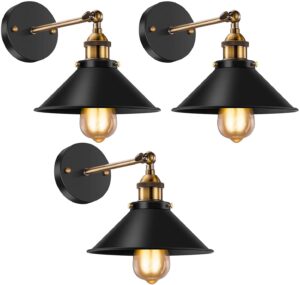
- Valance lighting: Personally my favorite, especially if you have a tiny kitchen. You can use valance lighting to provide accent lighting, capture the mode of colors in the kitchen, and still provide a reasonable amount of light for tasks. In the picture below, I personally used LED bar lighting for my cabinet lights, but LED strip lights or even recessed pot lights can work as well (but you’ll need custom cabinets for the latter).
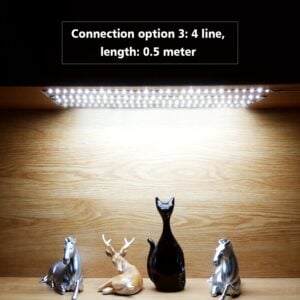
For kitchen lighting, I’d advise to have a mixture of natural lighting, cabinet lighting, and one or two wall sconces (if you don’t have recessed lighting in your ceilings). You want your tiny home to be functional due to it being such a small space.
You will also want to focus on lighting your countertops, near your fridge (most fridges are propane, so there’s no backlight) and around your sink to maximize lighting in your tiny home kitchen.
4. Subtle and unique lighting
There are a variety of subtle yet unique ways you can add lighting to your tiny home. Each of these serve a more functional mobility purpose, not so much the illumination of the entirety of your home interior. Here are some funky but cool ways to light up your tiny home interior:
- Stairwell lighting: If you have stairs in your tiny home, you can consider adding stairwell lighting. I’ve seen LED strip lights built into the back baluster of each stair tread. This makes the stairwell more like a landing pad (but is also extremely useful if you have a loft or second floor in your tiny home).
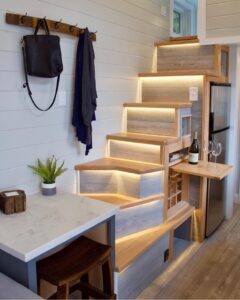 Sourced from https://tiny-estates.com/
Sourced from https://tiny-estates.com/ - Wall corner lamps: Definitely a more funky way to add light and very similar to a floor lamp, wall corner lamps follow the contour of a wall’s corner. You can buy them to just stand in the corner, or have them installed similar to strip lighting.
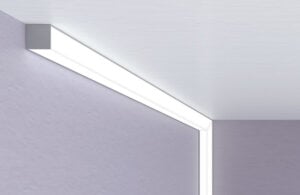
- Pendant lighting or chandelier: While I’ve advised against this, if you have the room (usually vaulted ceilings with a loft bed), then you may be able to fit lights like this.
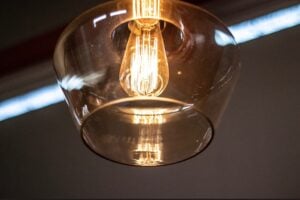
Outdoor lighting for a tiny home
Lighting for tiny houses needs to be different than that indoors. Most of your lights should be on a motion sensor and timer (to preserve electricity). Because living off-grid in a tiny house can feel isolating at night, outdoor lights can give you some peace of mind and security (not just a nice-to-have). Personally, I loved having property lights when I was growing up in the city.
5. Uplights:
A great way to spice up your property with some color and also draw light at night around key features like landscaping or doorways. Whether they’re wired or wireless, uplights can provide a degree of color and ambiance that most normal lighting strategies cannot. However, I would advise renting uplights first, trying them out on your property, and then purchasing if they end up working out for you. Making sure they are compatible with your electrical capacity and make sense in your location is really important.
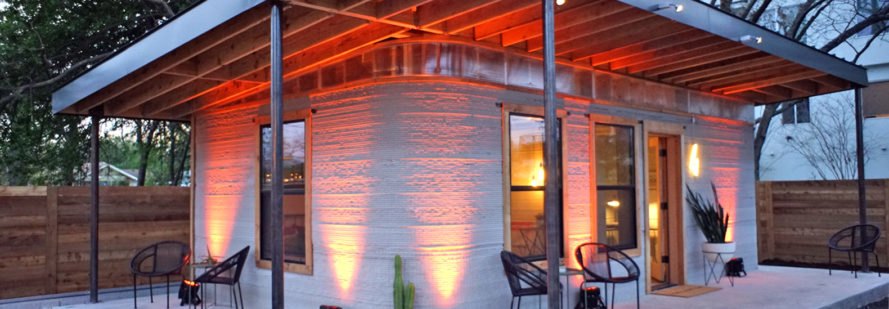
Sourced from https://newstorycharity.org/3d-community/
6. Flood lights:
Sometimes confused with uplights, flood lights are an easy way to cast a massive array of light on a large surface area. You can install one or two flood lights to illuminate the entirety of your tiny home. You should realistically install these in your home to illuminate a walkway or your parking area, and have these on a motion sensor for added security.
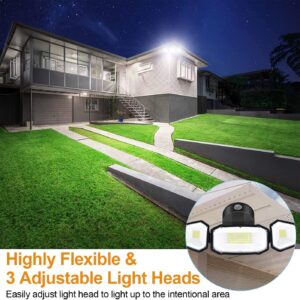
7.Post lights:
While fully wired post lights may be out of the question, small walkway post lights may be advantageous for you to install especially if you’re in a wooded or secluded area. You can mix three or four small fence post lights with some light reflectors to create a cool illuminated nighttime walkway effect.
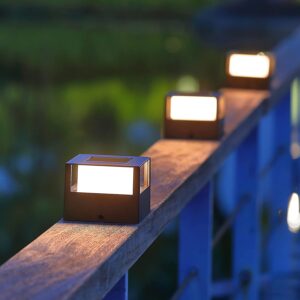
Your lighting strategy is crucial to living a successful tiny home life. This being said, it’s not easy due to the restrictions of electricity and space that tiny homes offer. This is why it’s important to factor tiny home lighting into your build so that you can succeed when it comes to living in a tiny house. Remember: Incorporating lighting into the design of your tiny home, both for indoor and outdoor lighting is important for both safety and comfort.
I hope this article gave you some helpful ideas for your tiny home. Let me know in the comments if you have any questions or comments about this content.
Frequently asked questions about tiny house lighting.
Can you make tiny house lighting dimmable?
You’ll need to inspect your light bulb to see whether or not it’s dimmable. Not every LED light bulb is dimmable, and it comes down to the particular components within the light bulb and your electrical system. Most fluorescent bulbs, lights, and strips cannot be dimmed because of their use of ionized gases. Therfore, I would stay away from most halogen lights. Trying to add a dimmer to a non-dimmable light can be very dangerous – always be sure to check with an electrician beforehand.
What’s the best light for a tiny house living room?
In my opinion, the best light for a tiny house living room is natural light (skylight or window) and a wall corner lamp because it fits with a tiny home owners’ minimalist mindset. While having wall sconces or pot lights is useful, it can be very energy-intensive.
How do you pre wire your tiny home with solar panels?
If you’re building your own tiny house (or designing it), be sure to check out some books like “Off Grid Solar Power Simplified.” Books like these will teach you how to use solar panels and convert that solar energy into electricity for your appliances (whether their DC or AC).